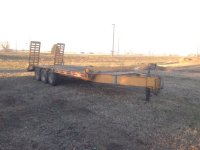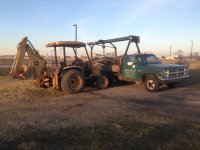leonz
Super Member
The key to excavation is preparation.
Using a portable cable trencher like the ones used to bury
propane feeder lines and cables are a very good way to
break old sod deeply beyond the deepest root depth of the sod and
shallow near surface tree roots.
By employing the cable trencher you can make multiple cuts in the marked area of
the grave site to cut up the sod uniformly without making mess and keeping the
collar of the burial hole uniform.
FYI and I want you think about this-
In Great Britain many graves are still dug by hand and grave diggers and cemetary's
have one piece steel or aluminum grave digging forms that are employed for digging graves.
The rectangular forms have a an upper and lower step that allow the digger protection from
a cave in by creating a narrow rectangular hole and then the hole is enlarged by digging back
under the form until the dirt and stones under the outer edge allow it to drop into the hole to
the depth of the step(riser).
The digging for the grave continues until the full depth is reached and then the form is removed.
By using the gas powered cable trencher this would let you employ a small tracked excavator with
high floatation tracks and a narrowed toothed bucket without tearing up more sod than needed.
The smallest tracked excavators have curved upper booms now that allow the machine to dig to
a deeper final depth allowing the user to work in more narrow excavations.
By using a thumb on the bucket you will also avoid spillage and avoid having large rocks fall out
and make a mess.
A tracked excavator would be of more benefit to you as you could move in and out of grave sites more quickly as you would be working from one position after you have laid your plywood down for the dirt pile.
You also have to remember that even the smallest tracked excavator has zero tail swing and will not
be "longer" or "wider" than the tracks.
Using a portable cable trencher like the ones used to bury
propane feeder lines and cables are a very good way to
break old sod deeply beyond the deepest root depth of the sod and
shallow near surface tree roots.
By employing the cable trencher you can make multiple cuts in the marked area of
the grave site to cut up the sod uniformly without making mess and keeping the
collar of the burial hole uniform.
FYI and I want you think about this-
In Great Britain many graves are still dug by hand and grave diggers and cemetary's
have one piece steel or aluminum grave digging forms that are employed for digging graves.
The rectangular forms have a an upper and lower step that allow the digger protection from
a cave in by creating a narrow rectangular hole and then the hole is enlarged by digging back
under the form until the dirt and stones under the outer edge allow it to drop into the hole to
the depth of the step(riser).
The digging for the grave continues until the full depth is reached and then the form is removed.
By using the gas powered cable trencher this would let you employ a small tracked excavator with
high floatation tracks and a narrowed toothed bucket without tearing up more sod than needed.
The smallest tracked excavators have curved upper booms now that allow the machine to dig to
a deeper final depth allowing the user to work in more narrow excavations.
By using a thumb on the bucket you will also avoid spillage and avoid having large rocks fall out
and make a mess.
A tracked excavator would be of more benefit to you as you could move in and out of grave sites more quickly as you would be working from one position after you have laid your plywood down for the dirt pile.
You also have to remember that even the smallest tracked excavator has zero tail swing and will not
be "longer" or "wider" than the tracks.

